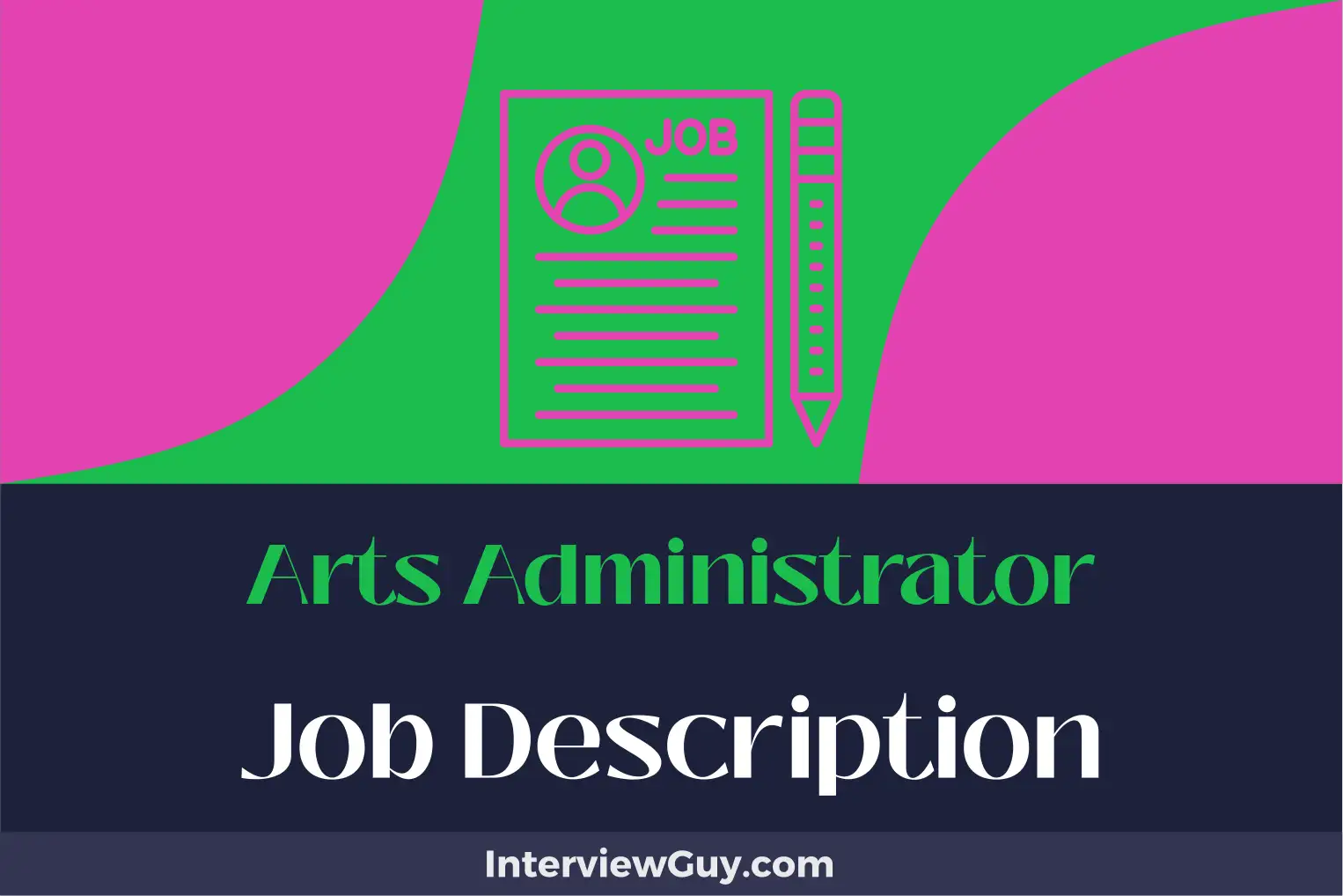Arts Administrator Job Description [Updated for 2025]

In the constantly evolving world of art and culture, the significance of arts administrators has never been more apparent.
As the art world continues to grow and diversify, there is an increasing demand for skilled professionals who can organize, curate, and protect our cultural landscape.
But let’s delve deeper: What’s truly expected from an arts administrator?
Whether you are:
- An aspiring professional trying to understand the complexities of this role,
- A hiring manager seeking to craft the ideal candidate profile,
- Or simply intrigued by the intricate workings of arts administration,
You’re in the right place.
Today, we introduce a customizable arts administrator job description template, designed for effortless posting on job boards or career sites.
Let’s dive right in.
Arts Administrator Duties and Responsibilities
Arts Administrators are responsible for planning, organizing, and managing arts events, programs, and organizations.
They also play an essential role in managing budgets, marketing, and relationships with artists and partners.
They have the following duties and responsibilities:
- Plan and organize arts-related events, programs, and exhibitions
- Create and manage budgets for arts programs and events
- Work closely with artists to develop and implement programs
- Coordinate logistics for events, including securing venues, hiring staff, and arranging transportation
- Develop marketing and promotional materials for arts programs and events
- Network with potential partners, sponsors, and donors to secure funding and support for arts programs
- Manage relationships with artists, partners, staff, and volunteers
- Assess the success of arts programs and events and make recommendations for improvements
- Ensure compliance with legal, health and safety requirements during events
- Handle administrative tasks such as correspondence, report writing, and record keeping
Arts Administrator Job Description Template
Job Brief
We are looking for a dedicated Arts Administrator to join our team.
In this role, you will be responsible for managing administrative tasks related to our arts programs and initiatives.
This includes organizing events, coordinating with artists, managing budgets, raising funds, and promoting our organization’s presence in the art community.
Our ideal candidate has a strong passion for the arts, excellent organizational skills, and experience in management roles within arts organizations.
Responsibilities
- Plan and execute arts events and programs
- Coordinate with artists and other stakeholders for event preparation
- Manage budgets and financial planning for arts initiatives
- Seek funding and sponsorship opportunities to support arts programs
- Promote the organization’s arts events and programs through various channels
- Develop and maintain relationships with local art community members
- Ensure compliance with laws and regulations pertaining to the arts sector
- Monitor and report on the effectiveness of arts programs
Qualifications
- Proven experience as an Arts Administrator or similar role
- Demonstrable passion for the arts
- Strong organizational and event planning skills
- Experience with budget management and fundraising
- Excellent communication and interpersonal skills
- Knowledge of laws and regulations related to the arts sector
- Ability to work effectively with diverse groups of people, including artists, volunteers, and community members
- Bachelor’s degree in Arts Administration, Business Administration, or a related field
Benefits
- 401(k)
- Health insurance
- Dental insurance
- Retirement plan
- Paid time off
- Opportunities for professional development in the arts sector
Additional Information
- Job Title: Arts Administrator
- Work Environment: This position is based in an office, but may require travel to arts events and meetings.
- Reporting Structure: Reports to the Director of Arts Programming.
- Salary: Salary is based upon candidate experience and qualifications, as well as market and business considerations.
- Pay Range: $45,000 minimum to $75,000 maximum
- Location: [City, State] (specify the location or indicate if remote)
- Employment Type: Full-time
- Equal Opportunity Statement: We are an equal opportunity employer and value diversity at our company. We do not discriminate on the basis of race, religion, color, national origin, gender, sexual orientation, age, marital status, veteran status, or disability status.
- Application Instructions: Please submit your resume and a cover letter outlining your qualifications and experience to [email address or application portal].
What Does an Arts Administrator Do?
Arts Administrators work in various arts organizations, such as theaters, galleries, museums, music organizations, dance companies, and arts festivals.
They may also be employed by universities or community organizations with an arts focus.
They are primarily responsible for the day-to-day operations of the organization, ensuring the smooth running of artistic events.
This includes planning and coordinating events, managing budgets, fundraising, marketing, and public relations.
Arts Administrators liaise with artists, curators, performers, and other staff to plan and implement programming.
They may be responsible for contracting performers or artists, securing venues, and coordinating technical and logistical aspects of events.
In addition, Arts Administrators often play a critical role in raising funds for their organizations.
This may involve writing grant proposals, organizing fundraising events, or developing relationships with sponsors and donors.
They also work to promote their organization and its programs to the public.
This can include managing social media accounts, working with the press, and developing marketing materials.
In summary, Arts Administrators bring together the creative and practical aspects of running an arts organization, providing the necessary organizational and financial support to ensure the success of artistic endeavors.
Arts Administrator Qualifications and Skills
Arts Administrators require a blend of artistic knowledge, administrative acumen, and interpersonal skills to effectively manage arts organizations and initiatives, including:
- Strong organizational and administrative skills to manage multiple projects, schedules, and budgets simultaneously
- Deep knowledge and appreciation of the arts to effectively collaborate with artists, engage with stakeholders, and advocate for the organization’s artistic mission
- Excellent communication and interpersonal skills to build and maintain positive relationships with artists, staff, donors, and the public
- Financial management skills to oversee budgets, fundraising efforts, grant applications, and financial reporting
- Strategic planning abilities to develop and implement plans for the growth and development of the organization
- Marketing and public relations skills to promote the organization’s events and initiatives, and build its public profile
- Problem-solving skills to address challenges and crises that may arise in the course of managing an arts organization
- Leadership and team management skills to effectively direct staff and volunteers, and foster a positive, collaborative work environment
- Proficiency in using office software, database systems, and social media platforms for administrative, communication, and promotional tasks
Arts Administrator Experience Requirements
Arts Administrators typically have a background in both arts and administration.
They may start their career in the arts as a performer, artist, or related role to gain firsthand experience and understanding of the field.
For administrative experience, entry-level candidates may start in a general office role, such as an administrative assistant or a department coordinator in an arts organization, like a museum, theater or arts council.
This allows them to gain an understanding of day-to-day operations, funding, and event management.
Ideally, Arts Administrators should have at least 2 to 3 years of experience in a related field.
Some roles may also require a strong understanding of marketing, public relations, and fundraising for the arts.
Therefore, experience in these areas can also be beneficial.
Candidates with more than 3 to 5 years of experience may have advanced into roles such as Program Manager or Director in their previous positions.
This experience is beneficial for managing teams, strategic planning, and overseeing large arts programs or initiatives.
Those with more than 5 years of experience often have a solid network within the arts community and have demonstrated success in securing funding or sponsorships for arts programs.
Such candidates may be ready for senior-level Arts Administrator roles or executive director positions.
Arts Administrator Education and Training Requirements
Arts Administrators typically hold a bachelor’s degree in arts administration, art history, business administration, or a related field.
Some roles may require a deeper understanding of the arts, requiring a degree in fine arts, music, theater, or dance.
To gain a competitive edge, many arts administrators pursue a master’s degree in arts administration or business administration.
An important aspect of an Arts Administrator’s training involves understanding the business side of the arts, including fundraising, marketing, and financial management.
In addition to formal education, experience in the arts, whether through internships, volunteer work, or employment, is beneficial.
Arts Administrators may also choose to obtain certification from professional organizations like the American Association of Arts Administration Educators or the National Guild of Community Arts Education, which can demonstrate expertise and commitment to potential employers.
Continued professional development through workshops, seminars, and courses is also highly recommended to stay current with industry trends and best practices.
Knowledge of technology, particularly arts-related software and social media platforms, is often necessary.
Arts Administrator Salary Expectations
An Arts Administrator can expect to earn an average salary of $50,294 (USD) per year.
The actual earnings may fluctuate depending on the level of experience, education, the size of the organization, and the geographical location.
Arts Administrator Job Description FAQs
What skills does an Arts Administrator need?
An Arts Administrator should possess strong organizational skills to coordinate events and manage artists or exhibits.
They should also have excellent communication skills to interact with artists, curators, patrons, and the public.
A good understanding of the arts, budgeting, and fundraising is essential, as is the ability to work collaboratively with others.
Do Arts Administrators need a degree?
While not always necessary, most Arts Administrators have a degree in art history, fine arts, or arts administration.
Having a master’s degree, particularly in arts administration or nonprofit management, may enhance job prospects.
Some positions may also require a background in business management.
What should you look for in an Arts Administrator’s resume?
Look for a mix of arts and management experience in an Arts Administrator’s resume.
This can include roles in galleries, theatres, or museums, fundraising experience, and administrative roles.
Many Arts Administrators also have volunteer or internship experience in the arts field.
Consider whether they have experience relevant to the specific arts discipline of your organization.
What qualities make a good Arts Administrator?
A good Arts Administrator is passionate about the arts and understands the intricacies of managing an arts organization.
They have strong leadership skills, are excellent problem solvers, and can work under pressure to meet deadlines.
An effective Arts Administrator is also highly creative, has the ability to think strategically, and can successfully manage relationships with a variety of stakeholders.
How can an Arts Administrator contribute to an arts organization?
An Arts Administrator plays a crucial role in shaping the direction and success of an arts organization.
They manage and coordinate events, oversee budgets, seek funding opportunities, and promote the organization’s mission.
Their work ensures the smooth running of the organization and can help increase its visibility and impact in the arts community.
Conclusion
And there you have it.
Today, we’ve given you a sneak peek into the intriguing world of an arts administrator.
Guess what?
It’s not just about appreciating art.
It’s about fostering a thriving arts culture and shaping the creative landscape, one project at a time.
With our comprehensive arts administrator job description template and real-life examples, you’re prepared to venture into this exciting field.
But why stop there?
Go a step further with our job description generator. It’s your next tool for creating precision-crafted job listings or refining your resume to perfection.
Remember:
Every project in arts administration contributes to the bigger, brighter artistic scene.
Let’s shape the arts culture. Together.
How to Become an Arts Administrator (Complete Guide)
Out of the Box Occupations: The Weirdest Jobs in the Market
The Trending Trailblazers: Jobs That Are Making a Statement
Beyond Bravery: What Drives People to Dangerous Jobs
Cash In On Comfort: Low-Stress Jobs That Still Pay the Bills (and Then Some)!

![Anesthesiology Physician Assistant Job Description [Updated for 2025]](https://interviewguy.com/wp-content/uploads/2024/04/anesthesiology-physician-assistant-job-description-768x512.webp)

![Entry-Level Game Designer Job Description [Updated for 2025]](https://interviewguy.com/wp-content/uploads/2024/05/entry-level-game-designer-job-description-768x512.webp)

![Curriculum Evaluator Job Description [Updated for 2025]](https://interviewguy.com/wp-content/uploads/2024/05/curriculum-evaluator-job-description-768x512.webp)
